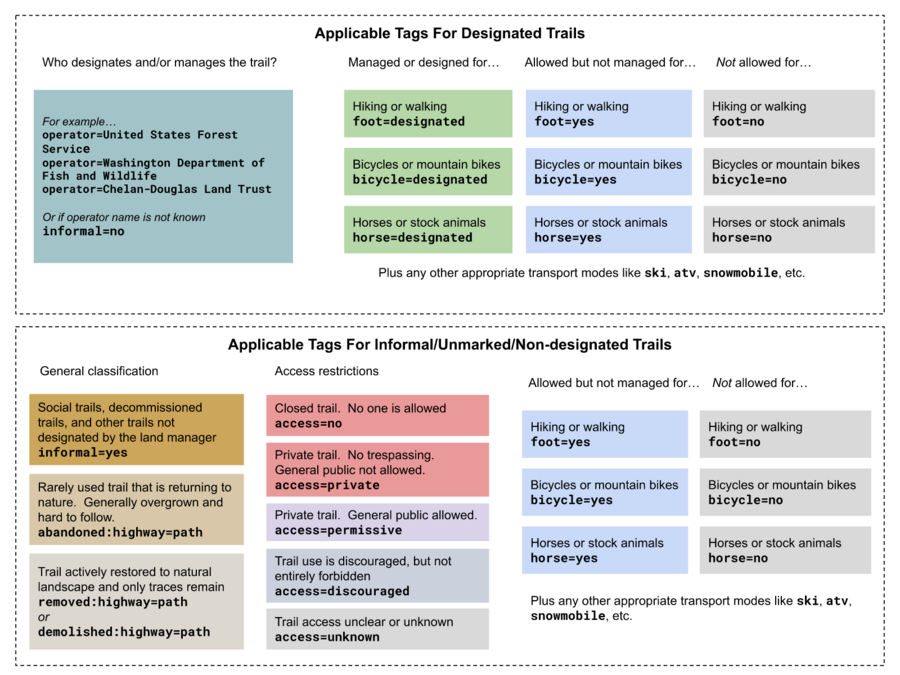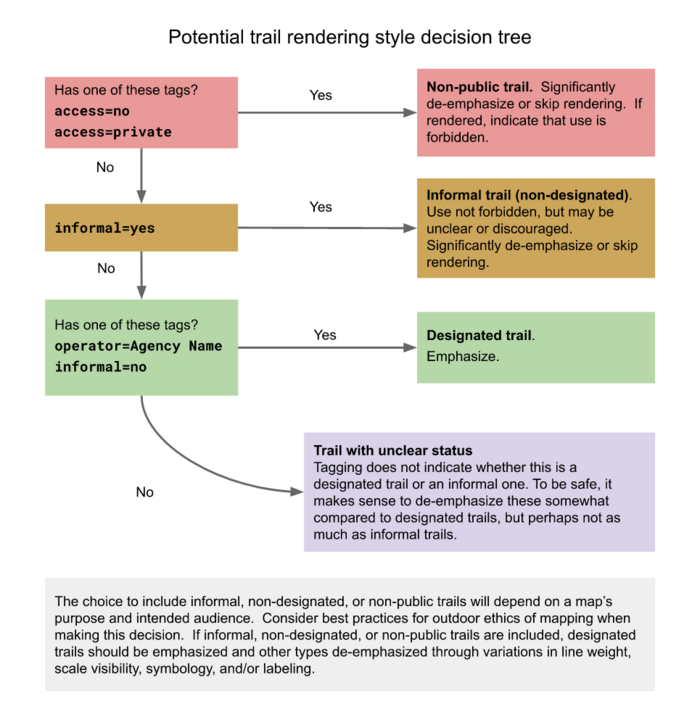User:Hedaja
Schon ewig dabei und trotzdem immer wieder am neue Dinge lernen.
Ich mappe alles, was mir vor die Nase kommt und gerade meine Aufmerksamkeit erregt.
Bin auch recht aktiv in den Telegram Gruppen
Archiv (Projekt OpenEmergencyMap)
Danfai und ich haben uns 2013 nach den schweren Hochwassern in Deutschland zusammengesetzt und Ideen für eine Anwendung zur Koordination von freiwilligen Helfern im Kriesenfall (Naturkatastrophen/...) zusammengestellt, um daraus ein Projekt zu machen.
Hier [Link] findet ihr eine Übersicht unserer bisherigen Ideen.
Es gibt bereits auch erste Prototypen für eine Webanwendung und eine Android App.
Der Quellcode für die Webanwendung liegt auf Github.
Da Danfai von uns beiden der einzige mit Programmierkenntnissen ist, sind wir bisher noch nicht so weit gekommen. Wenn jemand Interesse hätte beizutragen (egal ob nur mit Ideen oder mit Programmieren) kann sich vertrauensvoll an uns wenden.
Wir haben das Projekt aus zeitlichen Gründen auslaufen lassen, aber die Ideen haben wir an das ZUKS Projekt weitergegeben. http://prototyp.czuks.org/
Naturverträgliches Mappen
Nomenklatur
Das Projekt nutzt die folgenden Begrifflichkeiten:
- Offizieller Weg - Ein Pfad/Fahrweg, der sichtbar im Gelände ist und geräumt und/oder markiert ist.
- Trampelpfad - EIn unmarkierter Pfad, der jedoch genutzt wird und dadurch im Gelände sichtbar ist. zB ein Pfad der als ABkürzung genutzt wird.
- gesperrter Pfad - EIn Pfad der zwar sichtbar istm aber dessen Benutztung permanent untersagt (und als gesperrt markiert) ist.
- Way - Eine in OpenStreetMap gezeichnete Linie die einen Fahrweg oder Pfad kennzeichnet.
Plan of action
Proposed is the following plan of action:
| Phase | Actions Taken | Roles |
|---|---|---|
| 1. Establish tagging standards |
|
*Mappers: Collaborate on drafting tagging standards
|
| 2. Execute nationwide park trail tagging campaign |
|
|
| 3. Continuous monitoring of trail renderers |
|
|
Recommendations to land managers
Regulating traffic is one of the main Land Manager's methods to ensure safety of visitors, environment protection or owner's privacy. In reality this task can only be achieved in full coordination with all involved parties. In ideal case, 1) Land Managers ensure appropriate physical marking of trails and provide information about access restrictions. This in turn serves as information for 2) OSM members for correct tagging of the digital paths. These data are then used by 3) App developers to inform app users about accessibility of certain areas or provide routing that avoids restricted trails. Land mangers can afterwards evaluate visitors behavior and adjust the restrictive marking and devices, which triggers another round of this cyclic process.
In addition it is important to keep in mind that every individual visitor of the property is obligated to follow posted rules and restriction regardless of what the routing device or map might suggest. Experience shows that the vast majority of visitors care about nature conservation and owner's privacy and try to avoid breaking the set rules. If they are found trespassing it is often due to missing restrictive signs or accidentally not noticing the posted warnings. Therefore taking proactive measures in form of posted information can avoid vast majority of trespassing accidents.
Here are some of the possible ways how to inform visitors about trails and areas accessibility:
- Place no trespassing signs at the beginning of the closed or restricted social trail, or at the typical place where most visitors are expected to join such trail. Follow the rules or laws in your country/stare or jurisdiction about the correct appearance of the signs. (TODO: example of sign
- Post clear and simple rules at the entrance to the property such as parking lot that clearly state the rules for visitors. This could for example be a restriction to move only on the marked trail. (TODO: picture of information board at park entrance)
- Stretch do not cross tape or string around small areas that are undergoing nature restoration. In addition you can place an information text about the restoration process itself as visitors are more likely to follow rules if the know the purpose behind them. (TODO: get picture of marked restoration area)
- Build a set of marked trails as these serve as a clear guidance for the visitors and prevent off trail movement. Marking can have many forms such as painted blazes, tied ribbons, wooden poles, cairns, etc. (TODO: examples of trail marks)
- Provide map printouts for visitors. Providing small map printouts with trail clearly marked trails/areas that are accessible or restricted can prevent people from relying on apps containing inaccurately presented data.
- Post danger warnings signs before entrances to trails that are too difficult for average visitor or require a special gear. Such warnings along with pictures of the dangerous elements waiting ahead can deter many inexperienced hikers. (TODO: picture?)
Suggested Tagging
| Situation | Tagging | Style Vorschlag |
|---|---|---|
| Offizieller Weg |
|
|
| Gesperrter Pfad | Zugangs-tags beschrieben die Einschränlungen. Nutze access=no an einem Weg (zB highway=path) um zu kennzeichenen, dass dieser nicht betreten werden darf.
Für Wege in einem degradierten Zustand nutze lifecycle prefix for dem highway=* key, wie Zum Beispiel disused:highway=path oder abandoned:highway=path je nach Situation. |
|
| Kletterzustieg Anweg für zu Kletterfelsen, der nur für Kletternde freigegeben ist. |
||
| Trampelpfad (ohne Einschränkung) | ||
| Trampelpfad dessen Nutzung nicht verboten ist, jedoch jedoch davon abgeraten wird. (zB aus wegen Gefahren/Naturschutzgründen)
(gekennzeichnet zB durch Schilder/Markierungen oder auf einer offiziellen Karte/Webseite) |
gegebenfalls Gefahren mit hazard=* |
|
| Trampelpfad dessen Nutzung verboten ist
(gekennzeichnet zB durch Schilder/Markierungen oder auf einer offiziellen Karte/Webseite) |
||
| Ein Weg der nur durch den Eigentümer oder mit Nutzungserlaubnis begehbar ist. | ||
| Ein Weg der keiner ist (zB ein Wildwechsel) und als solches vermutlich von einem anderen Mapper nicht eingetragen würde |
|
|
| Ein Weg der keiner ist , aber eventuell aus verschiedenen Gründen (Topografie/GPX Tracks) als solcher erkannt werden könnte (zB ein Wildwechsel) |
|
OverpassTurbo-Query to display official (green), informal (yellow), discourage informal (orange), forbidden informal (red) and private (grey) paths.
Additional tags to consider
| Characteristic | Tagging |
|---|---|
| Sichbarkeit: Wie einfach ist es im Wegverlauf zu folgen. Wege mit schelchter Sichtbarkeit könnend azu führen, dass Nutzer sich verlaufen. | |
| Schwierigkeit: Wie anspruchsvoll sit die Nutzung des Weges. Wege in steilem Gelände, unsicherem Untergrund und Hindernissen können bei unerfahrenen Nutzenden zu Verletzungen führen. | |
| "Zustandsverfall" lifecycle prefixes: Zeigt an, dass ein nicht mehr ausreichend begangen oder gewartet wird und sich die Natur ihn langsam zurück erobert. Der prefix kann für jede Art Weg genutzt werden (zum Beispiel können stark zugewachsene Pfade als disused:highway=path, egal ob es sich dabei um Trampelpfade oder offizelle Wege handelt). Siehe Lifecycle prefix für eine vollständige Liste. |
Trail Tagging Chart
Suggested rendering and recommendations to data consumers
How trail information gets rendered by apps has a large influence on users when visiting natural areas. Indiscriminate rendering of all trails can cause risk of conflicts with private owners when moving on land that not intended for public use, damage to protected environment and cultural heritage, or serious injury. To limit such risks, we can adjust how is OSM data is represented on a map or inside a routing algorithm.
In the ideal case, the most prominent path features on a map are Official Trails, which can be identified by the Way representing the trail having a type=route + route=hiking relation or not containing access=private;no or informal=yes tags.
Closed trails, Social trails or Private trails are best not shown at all. However, sometimes showing such trails can help orientation in terrain or help in emergency situations. In such cases, rendering of these trails should be substantially less prominent or clearly marked as inaccessible, e.g. with X marks or displaying text PRIVATE/CLOSED.
Below is an example of a rendering decision tree distinguishing between designated official trails, unmarked/unofficial trails, social trails, and non-public/closed trails. Map makers will make varying choices about how exactly to render these trail types depending on the purpose of their map. For some purposes displaying only designated official trails may be best. For others, including all types may be appropriate. Ideally designated official trails should always be most prominent, with other types displayed less prominently if included.
See also
- Hiking
- Trail markings
- Proposed features/Social path
- Past community discussions:
- US National Park Service Tagging: Trails
- Australia/Walking Tracks







